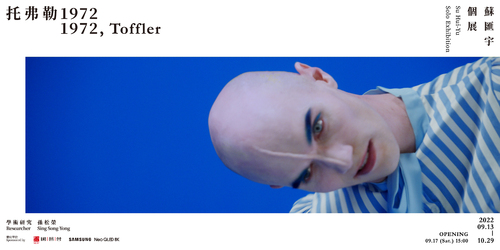1972, Toffler
9/13 (Tue) - 10/29/2022 (Sat)
Su Hui-Yu

Exhibition venue|Double Square Gallery
Opening reception|2022.09.17 (Sat.) 15:00
Researcher|Sing Song-Yong
●Exhibition Worklist
●Curatorial Essay: The Future of the Future: From Future Shock to Toffler 1972 - Written by Song-Yong Sing
●Artist's Talk
In a parallel universe in its late 1970s, “the last man on Earth” learns about a book of futurology someday, which is said to have precisely predicted the fate of the human race. So, he embarks on a journey to search for this book. In the quest, the protagonist traverses different dream-like scenarios of predictions about the human life and politics made in the book. - Su Hui-Yu
Double Square Gallery is delighted to present 1972, Toffler – Su Hui-Yu Solo Exhibition, which runs from September 13 to October 29, 2022 at the gallery; and art critic Sing Song-Yong is invited to serve as the exhibition researcher. The work presented in the exhibition features internationally renowned actress Wu Ke-Xi and famous drag artist Popcorn. 1972, Toffler marks Su’s third solo exhibition at the gallery. A sequel to Su’s Future Shock (2019), the exhibition features a brand-new video installation, photographic works, and sketches. The main work showcased in the exhibition – a video installation, titled Toffler, Oliver, and the Last Man on Earth (2022), draws inspiration from Alvin Toffler’s 1970 masterpiece, Future Shock, and is created with the approach of “re-shooting” – Su’s creative and signature method, which has become well-known in recent years – to embed imagination of the future from the 1970s in a contemporary context, and further lead the audience into an imaginary sci-fi world of “the future from the past” by interweaving human fragility, advancement and evolution of modern information technology, and predictions about life and politics. Toffler, Oliver, and the Last Man on Earth will also be shown in international film festivals in different forms in the future.
In recent years, Su has employed the approach of “re-shooting” as his method to create new works, which revisit past, unfinished, tabooed, and misunderstood figures, events, and things. Through his work, he is able to achieve new revelations or unveil active historical viewpoints. Sing Song-Yong, the researcher of the exhibition, thus comments on Su’s work in his essay written for the exhibition: “The key to the uniqueness of Su Hui-Yu’s work, in my opinion, lies undoubtedly in the fact that he acutely captures potential meanings of past cultural events in relation to his own generation, through which his works become bold statements about what has not been expressed in the past.” After being re-interpreted by Su and through his lens, a new life of controversial or seldom discussed works from past eras emerges.
The title of the exhibition is inspired by American futurologist Alvin Toffler’s book, Future Shock (1970), which was translated into Mandarin and published in 1972. In Su’s homonymous work, Future Shock of 2019, he utilizes the approach of re-shooting to re-interpret Toffler’s masterpiece, from which he applies keywords from new terms and notions proposed by Toffler to the narrative. Three years later, Su presents his latest work, Toffler, Oliver, and the Last Man on Earth, which continues the creative concept of re-shooting. However, different from the previous work that has a narrative based on chapters, the video work in 1972, Toffler is divided into several frames, combined with photographic works and sketches, which are shown in two gallery rooms. The images of the video show an endless road trip of the last survivor on Earth, accompanied by Oliver, a smart computer from the original book, invented as an aid to humanity. The labyrinthian style of visual expression prompts the audience to piece together the otherwise fragmented images by themselves, allowing them to choose their own viewing angle to approach and understand the work.